What is the difference between pansies and violas?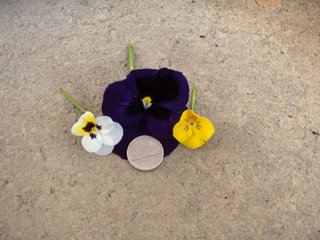 This is a question that I hear quite frequently this time of year. Violas (sometimes called Johnny Jump Ups) are simply a miniature version of pansy. Pansy flowers typically are about the size of a silver dollar. Viola flowers , however, range between the size of a nickel and a quarter. Both plants grow to the same basic height and width in the foliage. Violas, though, tend to have 3 - 4 times more flowers per plant at any given moment. So, while their individual flowers are less than half the size of a pansy, for color and show the two plants are fairly equivalent. They both also have the same food and care requirements. If you can grow one the other will be no problem. One big difference between the two plants is that violas tend to be more shade tolerant than pansies.
This is a question that I hear quite frequently this time of year. Violas (sometimes called Johnny Jump Ups) are simply a miniature version of pansy. Pansy flowers typically are about the size of a silver dollar. Viola flowers , however, range between the size of a nickel and a quarter. Both plants grow to the same basic height and width in the foliage. Violas, though, tend to have 3 - 4 times more flowers per plant at any given moment. So, while their individual flowers are less than half the size of a pansy, for color and show the two plants are fairly equivalent. They both also have the same food and care requirements. If you can grow one the other will be no problem. One big difference between the two plants is that violas tend to be more shade tolerant than pansies. 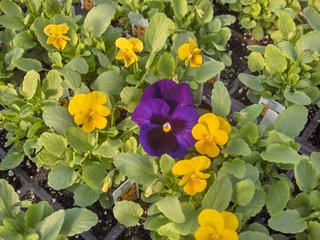 Both plants love full sun but violas will still bloom in shadier areas, where as your average pansy will not. Many people choose one or the other in their flower beds but mixing them in the same bed makes a beautiful show. Use pansies in the center of your flower beds and use the violas as an edger (outline along your bed). Then stand back and enjoy the compliments!
Both plants love full sun but violas will still bloom in shadier areas, where as your average pansy will not. Many people choose one or the other in their flower beds but mixing them in the same bed makes a beautiful show. Use pansies in the center of your flower beds and use the violas as an edger (outline along your bed). Then stand back and enjoy the compliments!
Gardening and Landscaping by PRWeb
Saturday, September 30, 2006
Pansies vs Violas
Posted by
The Plant Pixie
at
4:03 PM
![]()
Fall Has Arrived!

It's pansy season people! I just love pansies and violas. Pansies are one of the few plants I have encountered that come in any and every color imaginable. Not only do pansy flowers come in every color of the rainbow but they are also available in any mix of colors at your local nursery. You want an orange and purple flower? Red and yellow, perhaps? No Problem!
Not only do pansies come in a beautiful array of colors but they are also one durable little plant here on the southeast coast. When properly cared for your pansies will last from October up until May of the following year. That is 7-8 months of continuous color from one little plant! That is a great investment for anyone's garden. The only weather pansies can't tolerate is our hot, hot summer months. (And really, who can blame them!) During the winter, however, pansies can stand up to the worst mother nature has to offer. Neither icy rain nor snow will harm them. So the next time someone calls you a pansy take it as a complement!
Posted by
The Plant Pixie
at
12:34 PM
![]()
Tuesday, September 26, 2006
Flowers and Fashion
Okay, I admit it. When I first started working in a nursery I was a neophyte. I knew next to nothing about flowers. My boss told me that pointsettias don't really flower but the leaves change color. I thought he was just teasing me! I had spent months anxiously awaiting flower buds. Well, live and learn.
However, lately I have noticed that the flower industry is a lot like the fashion industry. There is always a new it plant that everyone and their neighbor has either seen on TV or in a magazine and just must have for their own garden. Often times regardless to how acceptable their garden environment is to said plant.
My choice it plant this year is Tacoma Stans (a.k.a. Yellow Bells). 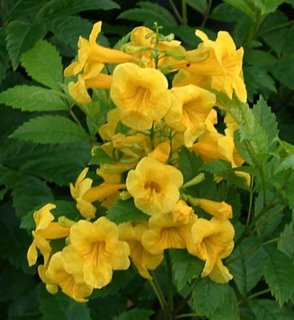 This plant is durable, forgiving and hardy. Yellow bells is fairly wind resistant and doesn't mind poor sandy soil. It is drought tolerant and can survive our brutal summer months. It also has the cutest cheerful yellow flowers all along the stalks. These flowers smell just like cotton candy. (No, really they do!) The plant can grow several feet tall but will also drape down beautifully in a hanging basket. All in all, Yellow Bells is one of the best new plants I have tried this year and I have thoroughly enjoyed them in my garden this summer.
This plant is durable, forgiving and hardy. Yellow bells is fairly wind resistant and doesn't mind poor sandy soil. It is drought tolerant and can survive our brutal summer months. It also has the cutest cheerful yellow flowers all along the stalks. These flowers smell just like cotton candy. (No, really they do!) The plant can grow several feet tall but will also drape down beautifully in a hanging basket. All in all, Yellow Bells is one of the best new plants I have tried this year and I have thoroughly enjoyed them in my garden this summer.
Posted by
The Plant Pixie
at
10:06 PM
![]()
Fun Plant Names
Have you ever wondered who assigns names to plants? 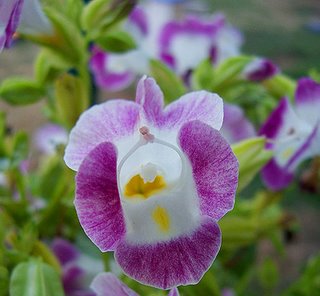 Most plants have scientific names that even a Latin enthusiast would stumble over. Fortunately for us common folk, most plants have 'common' names that are much easier to remember. Some of these are really quite clever.
Most plants have scientific names that even a Latin enthusiast would stumble over. Fortunately for us common folk, most plants have 'common' names that are much easier to remember. Some of these are really quite clever.
One of my favorites is the Wishbone plant (a.k.a. Torenia Fournieri). The stamen inside the flower literally look like a miniature wishbone. This common name is both descriptive and easy to remember. Once you see the visual image, one is unlikely to forget it's name. Where as the name Torenia might easily slip your mind when you are shopping around next season.
Another plant with an amusing name is the Snapdragon (a.k.a. Antirrhinum majus) . Try viewing the flowers from the side instead of from above. With a little bit of imagination one can see the flower as the head of a traditional dragon, crest and all. The "mouth" of the flower will even pop open and snap shut with slight pressure on the base of the flower. This is an especially amusing treat when walking through the garden with children.
My third entertaining 'common' name for the day is the lovely little balloon flower(a.k.a. Platycodon grandiflorus). When this 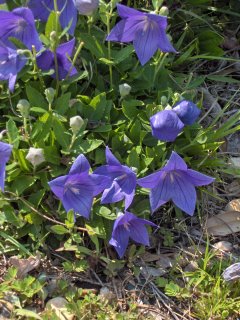 plant is tightly budded it looks very much like a bunch of little pink, white, or blue balloons floating above the plant. If one gently squeezes the flower you can feel the air pressure inside. Warning! Squeeze too tightly and the bud will 'explode' prematurely and die. The balloon flower will pop open in it's own time to become a beautiful flower.
plant is tightly budded it looks very much like a bunch of little pink, white, or blue balloons floating above the plant. If one gently squeezes the flower you can feel the air pressure inside. Warning! Squeeze too tightly and the bud will 'explode' prematurely and die. The balloon flower will pop open in it's own time to become a beautiful flower.
These three names are my top favorites of all the common names of flowers that I have encountered. I think each of them are descriptive and easy to remember. Heard any good ones yourself?
Posted by
The Plant Pixie
at
7:48 PM
![]()
Gardening & Horticulture Info Coming Soon!
Please bear with us as we get this blog site together... :)
Thanks for your patience!
Posted by
The Plant Pixie
at
1:45 PM
![]()










